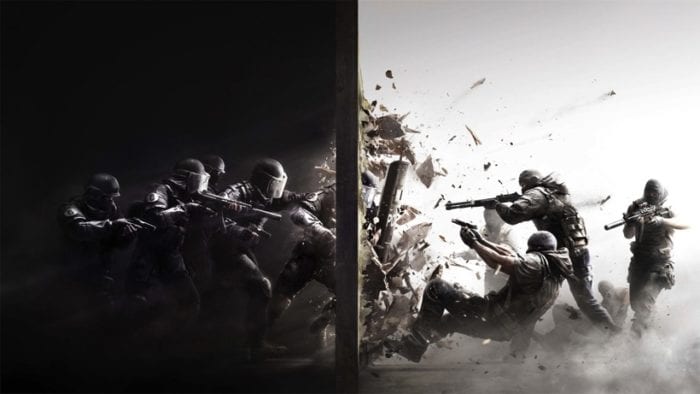The best way to fully articulate why Rainbow Six Siege is a special game, I’ve found, is to simply share an experience. One time, when playing as Glaz (the only operator in the game with a long-range scope), I was hanging out on the side of a building outside of the objective room. All teammates were dead and there were still two more enemies holed up in the room waiting for me.
They had a big advantage: time was on their side, they had fortified walls I couldn’t breach, and enough manpower to cover their flanks.It seemed like suicide to simply breach the nearby window and hope to pick them off. So, I went with the least terrible idea.
I deployed my drone, looped around the first floor and up the stairs to the objective room, drove under the door frame, and used its targeting to mark both of them with a little arrow. Using those as a guide, I simply shot straight through the window directly into the both enemies’ heads. They never even saw me.

Those are the moments that make Rainbow Six Siege–when you realize you’re competing in an environment with vastly different rules than what we’re used to with multiplayer shooters. Its biggest strength is not its impressively destructible environments, but the way its tactical edge, harshly realistic(ish) damage model, and brilliant collection of operators with abilities that counter each other mesh together so naturally.
Where most multiplayer shooters place their competitive edge on the question of who can get their shots off first or better, Siege often favors the player who plays smarter over the one with superior reflexes. It’s a game about catching your prey off-balance or by surprise, and not in the Call of Duty “we were both running around aimlessly and I saw you first so I win” way, but rather the “I punched a tiny hole in this wall just big enough to see the feet of who I’m about to shotgun straight through the cheap plaster” way.
Sure, it helps to be a sharp shot, but the game favors methodical and careful infiltration over relying on reflexes. Well-integrated peeking mechanics that work best when crouching and crawling around cover create an extremely tense atmosphere against the complete absence of music and the constant sound of boots clunking against wood and metal.
And this reliance on tactics is why spectating a match can often be as thrilling as playing. Never have I seen a shooter that so often comes down to unfair 1v3 circumstances just to be flipped on its head in a matter of seconds. All it takes is a careful defender who picks the right place to make their stand.

The game treats its operators more like heroes in MOBA’s that each have unique abilities. Except, whereas a MOBA hero is defined by what it can do, your operator matters mostly in the periphery. Your primary weapon is your smarts, while your operator’s ability is a tool to mix things up–like bulletproof barricades, a fuze charge that plunges pucks of explosives into the adjacent room, a cardiac sensor that detects heartbeats through walls, a riot shield equipped with flash charges, a drone that fires sonic charges to disorient enemies, or just a damn sledgehammer that decimates anything weaker than stone, to name a few.
Every operator is useful and mixing these tools helps to make matches feel different, but they aren’t the focus. That honor goes to the players themselves and how they handle situations.
Suffice to say, Rainbow Six Siege is a very different game than anything offered in the AAA landscape right now, and that’s something that many people seemed to misunderstand about it when it released in December of last year. It was often compared to the likes of Battlefield, Counter-Strike: Global Offensive, and even Call of Duty as if its divergence from those styles was a problem when, in truth, it’s the entire reason the game is special.
Though, the big problem at the game’s launch was its abundance of quality-of-life problems–the most noticeable of which was a completely unreliable network. Matches were often dropped, poor latency had players appearing around corners when they shouldn’t, and the first six months of the game’s life saw an overwhelming cheating problem that took too long to fix. There was also a noticeably small number of maps that seemed to rotate too quickly.

That said, Ubisoft Montreal has done anything but abandon Rainbow Six Siege in the past 12 months. In fact, they’ve vehemently made changes to operators to further balance, added eight new operators as a part of the season pass, added a wealth of free maps that successfully freshens the rotation, mostly fixed its connection issues (players still drop sometimes), and implemented a new cheating middleware in BattleEye that killed the problem overnight. The result is a game that feels like what it should have been when it released, and it has never been a better time to love the game.
Ubisoft shows no signs of stopping this support, either. As recently as Dec. 15, a big patch hit that tackled a laundry list of bugs, tuned operators for balance and added a new map to the PvP playlist that was previously only in the PvE mode Terrorist Hunt.
And with the new upcoming operators coming in the Year 2 content and the Six Invitational tournament happening in February, it’s clear that they’re in it for the long-haul.
Don’t let the generic military look fool you, because Rainbow Six Siege is one of the most unique and polished shooters out there right now, and well worth your time a year later.














Updated: Dec 29, 2016 09:31 am